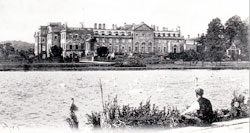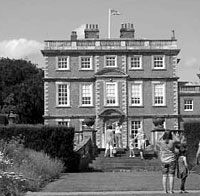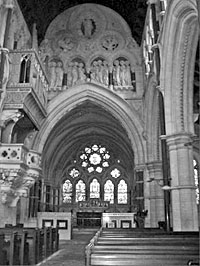Events and excursions, Autumn 2014
Visit to the Welbeck Abbey State Rooms on 18 September 2014
Outings Organiser ALAN LANGTON reports on the Society's third visit to Welbeck Abbey

Bags and cameras were not allowed on the tour so no up-to-date photograph could be provided. This highly romantic view of Welbeck Abbey is on a postcard posted on July 26 1907 from Worksop to Scarborough. (Collection Howard Fisher).
Members of the Thoroton Society first visited Welbeck Abbey in 1899, when the Sixth Duke of Portland was the President of the Society. Much history has passed under the bridge since then, including the occupation of the site by the Army for a number of years, until they moved to new premises in Leicestershire a few years ago. The Abbey dates back to 1153, when it was founded as a Premonstratensian monastery. It became a stately home with the ownership by the Cavendish-Bentinck family in 1607, and has remained so ever since.
We were met by our two young and competent guides at the Harley Gallery by the Dukeries Garden Centre, and taken by coach to the main entrance of the Abbey. The journey through the grounds was full of interest: we were surprised particularly by the size of the estate, which is not appreciated by just a visit to the Garden Centre.
We passed through Welbeck village, which included seeing the almshouses erected by the Duke's wife, Winifred, known as the 'Winnings' because they were paid for by money the Duke won in seven horse races.
We also saw the 5th Duke of Portland's Hunting Stables and Riding House, all in good repair.
After the death of the sixth duke in 1943 the Abbey and grounds were occupied by the Army as Welbeck College. Members of the Cavendish-Bentinck family now reside in the Abbey again, and they have made major repairs and restoration of the inside of the Abbey rooms. They created a grand interior fit for Edwardian high society, and enjoyed entertaining guests including royalty.
The Entrance Hall with its fan-vaulted ceiling was a stunning introduction to our tour of the state rooms of the Abbey: the ceiling dates back to the plans of the Countess of Oxford in 1751. As we toured the other rooms we saw some magnificent examples of art and ceramics, a collection which was started by Robert Harley, the first Earl of Oxford, and which has been built up over the generations by successive members of the
Cavendish-Bentinck family into what is now described as one of the finest collections of British portraits and miniatures. After the Library we entered the Red Tapestry Drawing Room with its complete set of Gobelins tapestries dated 1783. From here we saw the Swan Drawing room, followed by the State Dining Room.
The walls of the Arts and Crafts Print corridor were covered with portraits and prints of much historic interest. The tour ended with the Titchfield Library and the Chapel, now used three times a year, chiefly for charity carol services.
The whole tour spoke of a lived-in home surrounded by treasures of priceless value and beauty.
We only saw part of the Portland collection on our tour; it is interesting to note however, that a new gallery is under construction, which will house more of the Portland Collection - the promise of more delights to be seen in the future, which are currently in store.
Newby Hall, Ripon
Outing Leader, ALAN LANGTON, reports of the Society outing of 7 August 2014.


Photographs of Newby Hall and church by Josephine Burgess (originals in colour).
What might have appeared to suggest rather a long journey to our destination in fact in the event proved relaxing and enjoyable on a delightful summer's day.
We were met and welcomed by the administrator for group visits at the Hall, and taken immediately to enjoy coffee and home-made biscuits.
We were then taken to meet the guide who took us round the Hall for an hour's tour full of information and historical interest.
The Hall is still lived in by the Compton family, who have occupied the estate since 1748. Visitors have a feeling of domestic naturalness as they walk around, but at the same time each room has an immaculate appearance, specially since major restoration of the decorations and ceilings in the late 1980s. Robert Adam's neo-classical design dominates the Entrance Hall and displays exquisite plasterwork and Chippendale furniture. All the
ceilings are outstanding, and as we passed through the Boudoir and the Red Passage members were impressed by the paintings and the furniture and collections of china.
The Drawing room and the splendid Dining room caused members to look with awe at the beauty around us. Moving to the Victorian wing of the house, we were aware of the previous owners' successful passion for horse racing and collecting old oak furniture and chamber pots! The various bedrooms, with bathrooms, display a fascinating mixture of antique furniture and modernised facilities. Returning downstairs, we entered the Staircase Hall and the Ante-room, full of family treasures and portraits.
The walls of the Tapestry Room are covered with Gobelins tapestries, originally ordered in Paris in 1763, and the floor is covered with English Axminster carpet: the whole room and its furniture were designed by Adam and Chippendale, and creates a stunning display of wealth and beauty. The Library with its apsidal ends and Corinthian capitals again creates a feast of stunning ceilings and furniture. The Statue Gallery is probably based on Adam's sketches of Roman ruins at Tivoli, and was designed to enable guests to move from the dining room into what appears to be an ancient temple: the room is said to contain perhaps the finest collection of Roman statuary in private hands in Britain. After a most enjoyable lunch, members were free to enjoy walks in the lovely gardens, visit the Plants' Centre, or even take a ride on the minature railway along the picturesque riverside track.
Unfortunately a serious holdup on the A1 caused us to arrive back an hour later than planned, but otherwise we enjoyed a beautiful day in perhaps one of the most outstanding great Houses that Thoroton members have visited.
Saint Mary's Stow in Lindsey and Doddington Hall
The Society's outing of 11 September 2014 is reported by joint leader Penelope Messenger. Penelope's co-leader was Margaret Trueman
After a pleasant run into rural Lincolnshire, the coach arrived at Saint Mary's Church, Stow, where we were met by the news that the whole village was suffering a power cut! Fortunately, the Church Warden, Mr. Allan Marshall had filled thermos flasks with boiling water, and so was able to provide us all with coffee and biscuits.
The first impression of Saint Mary's is of a building too large to possibly be a parish church of such a small village; but stepping into the building created a sense of awe: some people simply uttered 'wow' since it gave the impression of being a small medieval cathedral.
We were very lucky to be given a fascinating account of the history by Mr. David Justham, who seemed to know every stone and carving in the building.
The church was founded in 975 by Bishop Aelfrith and intended to be the head Minster for the Lincolnshire part of the large Diocese of Dorchester. The original church was burnt down and then rebuilt by Bishop Eadnoth (1034-1050) and later endowed by Leofric, Earl of Mercia in 1067. Remegius, the first Norman Bishop of Dorchester moved his see to Lincoln, and so Saint Mary's eventually became a (very large) parish church.
The south wall of the south aisle has windows of three different architectural periods - Saxon narrow slit, a later Norman round window, and a two-light Gothic window.
From Stow we travelled to Whisby garden centre for lunch, and then on to Doddington Hall. The House is an impressive Tudor building designed by Robert Smythson in 1595, and still retains its walled garden and gate house. The house has never been sold, and has passed down through generations of the family, sometimes through the male line and frequently through the female line. As a result it remains very much a family home, and its contents reflect the tastes of 400 years of family collectors.
After the tour of the house we enjoyed a generous tea in the modern Garden Wing. Finally we had time to visit the church or the gardens or the farm shop before returning to Nottingham.
Meeting Report The Hallaton Treasure
Meeting Chair, BARBARA CAST reports on the lecture of 11 October 2015

The lecture on 11 October was excellent. We were really pleased to be able to welcome as the speaker Peter Liddle and to hear about the finding of the shrine near the village of Hallaton in Leicestershire and its famous 'treasure'.
Peter Liddle was a site archaeologist during and for three years after university. He then joined Leicestershire Museums in 1976, and in 1977, became Keeper of Archaeology, responsible for the county's museums and for the planning and recording of archaeology. After early retirement from this post he became Community Archaeologist for the county. In all Peter worked for over forty years in Leicestershire archaeology and this includes his work with local communities, helping them discover their own area's past.
As part of his community archaeology role he was material in setting up the Hallaton Fieldwork group which found the site on which the talk was based. Peter was involved in the Hallaton project all through and was instrumental in ensuring that there was a splendid display of the finds in Harborough Museum.
At the beginning of the well-illustrated talk Peter reminded us that the event which Hallaton was most famous for was the annual Easter Monday custom of Bottle Kicking.
Peter went on to explain that in the 1970s Leicestershire was keen to speed up gaining knowledge of its county's history and so the Leics Fieldworkers was set up. Learning to fieldwork was the first task, for Peter as well as his colleagues and volunteers. With 150 members and twenty local groups on the go at any one time, it has been a busy period for Peter.
One of the early groups was the Hallaton Fieldwork group and, at its first session of field walking, and in the first field they ventured into, Roman finds came up. But when they came to the area in which the treasure was subsequently found, it didn't look particularly special - some Roman pottery and tile were found but then - Iron Age coins kept being found, and found!
The initial find was made by Ken Wallace on 19 November 2000, when he found about 130 coins in just one area of the field. On examination they were found to be mainly silver and gold Iron Age coins. Luckily at that time English Heritage had enough money to pay for the investigation of treasure sites (the second year of investigation was partly funded by the BBC), and Leicester University Archaeology were commissioned to supervise the dig, which was also a fully community project throughout, with many local people involved.
Early in the excavations, six Iron Age hoard spots were found, just inside what appeared to be the gateway to some kind of sacred place. There was also a palisade trench, further indicating an enclosure of some kind, and ditches with dog burials. These two dogs were large and were therefore assumed to be guard dogs, buried near the gateway they had guarded. Just outside the gateway was the burial place of a mass of immature pigs - were these sacrifices? Other finds included a silver bowl, the earliest silver craft piece found, and a very fragile but beautifully crafted silver-gilt Roman parade helmet with seven cheek pieces! This was carefully conserved over a period of years at the British Museum and can be seen at the Harborough Museum.
In many ways it was the number of Corieltauvi coins found on this site that was staggering - over 5000 altogether at this site alone, more than have been found in the East Midlands in total. The latest was a Claudian coin of 42AD. Coin moulds found in Leicester attest to some of these coins being minted in the city.
Moving on from this sacred site, geophysical surveying was undertaken on the same hilltop, where a chapel was believed to have stood; the chapel of St. Morrell, a site of pilgrimage in use from 12th to 16th centuries. The surveys indicated that there were indeed features commensurate with a building and its precincts. Excavations revealed the chapel foundations, tiled floor and remnants of walls and window lead. There was clear evidence of pilgrimage in the form of a pilgrim badge, many silver coins of the period of use and also burials, which are not usually associated with chapels. Two of the skeletons received coverage similar to that of the Hallaton Treasure, being found, a woman and a man, buried apparently with linked arms.
As Peter explained, this was a place of continuous sacred use, as there were indications of a Roman temple under the chapel, the sacred Iron Age site was nearby and, for an example of truly long-term continuity, the Easter Monday Hallaton Bottle Kicking tradition has had for its starting point, from time unremembered, this same special place.
Hallaton Fieldwork group is still going from strength to strength. Peter himself retired from his Community Archaeology role in 2012 and now spends his time in many archaeology related activities: lecturing, as an honorary visiting fellow of Leicester University, as Chair of Judges for the British Archaeological Award for Community Archaeology and on the editorial board of the Journal of Community Archaeology. He received his MBE for services to community archaeology.
Many thanks to Peter for a fascinating look at this East Midlands site. We certainly found that there is much more to Leicestershire than finding a lost king!
Home Front
A large audience enjoyed the joint day-school event held by the Thoroton Society and the Nottinghamshire Local History Association at Ravenshead on 25 October 2014 which considered the impact of the Great War at Home in Nottinghamshire. A great deal of planning had gone into the day and as well as 10 speakers there were stands and stalls to be visited and money spent on books!
After the initial introduction by John Parker (Chair of NLHA) the keynote adress was given by Chris Wrigley (Emeritus Professor of Modern British History, University of Nottingham). Prof. Wrigley talked about Arthur Marwick's 1962 reassessment of the Great War and notion that 'the bigger the war, the bigger the social change it caused'. Marwick's comments caused a reaction against his views whereas J. Winter in 1985 suggested that 'the worse off the sector was pre-1914, the better they became'. The speaker discussed these and other notions and suggested that during the war period cost of living increases outstripped wage rates in a full labour market created by huge demand. Women's role in the workplace shifted from domestic and textiles to war work and lifted the fitter from the workhouse but not children and the infirm. It was an interesting and very thought provoking introduction to the day.
Elizabeth and Michael Jones, (a science teacher and Emeritus Professor of Medieval French History from the University of Nottingham respectively) outlined a project on which they have recently started to work, about Norwell in the First World war.
Sources were listed and the disappointments of no mention of the start of the war in school log books because it was school holidays, nor mention of the end of the war because school had been closed for two weeks due to the outbreak of the flu epidemic.
During the war patriotic fund-raising was undertaken and in 1918 National Blackberry Day saw 769 lbs of berries picked by the village.
Ted White talked about the journal produced by Boots for its staff and those from Boots who had volunteered for the forces -Comrades in Khaki. The intention was to maintain links between the factory and the soldiers and also used to encourage recruitment, something that Jesse Boot was very keen to see from his staff; to report news from the front to reassure those at home; obituaries of men who had been killed; anti-German propaganda, give the troops news of happenings at Boots and to raise money for the benefit of the sick and wounded.
The magazine closed on 1 May 1916 due to a lack of labour and difficulties in obtaining paper. It lasted for one year and had 12 editions. The journal is now sought after by collectors but copies can be found in some local archives.
Christine Drew overcame her physical difficulties to deliver a fascinating and well illustrated account of the prisoner of war camp at Sutton Bonnington (known to the the authorities as Kegworth Camp) and also the camp at Donnington Hall.
These camps were for officers, many of whom arrived with lots of luggage. Christine had several amusing elements to her talk. She outlined the background to the building of POW camps of which there were 50 in the UK, 13 of which were for officers and some for civilian internees. Of the total of 507.000 prisoners of war taken by the allies, 128,000 were housed in the UK.
Sutton Bonnington camp was set in the buildings and grounds of the Midland Agricultural College, now the campus of the Agricultural Department of the University of Nottingham. It was surrounded by two 9 feet high electrified wire fences and other security elements were a daily roll call but generally security was lax and 22 officers made an escape through a narrow tunnel - all were recaptured within six days.
Christine was followed by Jill Oakland who gave a talk about the VAD hospital based at the Cedars in Beeston.
This house had been owned by the Poyser family (Nottingham jewellers) but when put up for sale in 1914 was bought for use as a hospital which opened in February 1915.
Despite records not been greatly available, Jill had traced some of the occupants and nurses involved and also outlined the condition in which the VAD ladies worked.
After lunch Pauline Marples enlightened us about the Army training camp at Clipstone.
Pauline's work is the subject of a popular exhibition at Mansfield Museum and a very interesting book. Clipstone was a very large camp which at its height contained 5,000 men being trained for Army service.
The camp closed in 1920 with its huts being sold off; there are still some to be found in Forest Town to this day.
Robert Ilett explained the situation of Worksop in the period immediately before the War started. It was a town which had shifted from depending on maltings, agricultural services and woodturning to being a colliery town with three pits in its proximity.
Val Wood discussed the impact the war had on women and children. Val explained the poor situation of mothers and babies; that Nottingham relied upon voluntary organisations to provide essential care for them and that the changes brought about by the war lead to welfare reforms after the war ended.
Faith Blakemore and Neil Bettison talked about the Trent to Trenches exhibition work and the grants available to local organisations doing war related research.
Professor John Becket brought a fascinating day to an end with a succinct and penetrative analysis of the talks and also suggested other aspects which the day had not covered.
The Annual Luncheon, 2014
Barbara Cast reports on the Annual Luncheon held on Saturday 1 Novmber 2014
This year we were in Edwinstowe for our lunch, at the Forest Lodge Hotel to be exact. The sixty-five Society members and guests were accommodated most appropriately in a former barn, now converted to an attractive dining room.
As usual we were welcomed by our Chair, Professor John Beckett, and then led in grace by Alan Langton.
Our lunch kept up the standard to which we have come to expect at this annual Society event with a splendid three course meal, ably served by the friendly staff.
After lunch we raised our glasses for the toasts, John Beckett proposing that to the Queen and Penelope Messenger that to the Society in which she reminded us of the rich programme and publications we enjoy during the year and thanked those who were responsible for providing them. President Adrian Henstock responded to the toast with his thanks and a resume of the history of our nearly one hundred and eighteen year old Society in the context of similar historic literary and antiquarian bodies in other parts of the country. He particularly focussed on a remote library in Perthshire, founded in 1680, and Bromley House, founded some 130 years later. Adrian also reminded us of the need to keep foundations such as these and ours relevant to the 21st century.
He said that the Thoroton Society has moved forward considerably in this regard, with a most useful website, online bibliography and the Heritage Gateway all holding a wealth of information. However, we do not forsake our traditional publications and yearly programmes which are much appreciated and enjoyed by our members.
Our after lunch speaker was Professor Charles Watkins of the University of Nottingham School of Geography who gave us a very appropriate talk, seated as we were in Sherwood Forest country, on the Ancient Oaks of Sherwood Forest. Charles' expertise and special interests lie in rural land management, the history of forestry and the conservation of Sherwood Forest. He is a trustee of the Sherwood Forest Trust.
We were all fascinated by his talk which was accompanied by a useful booklet full of pictures and quotes about the trees of the forest, some dating from the 18th Century. One of the interesting men noted by Charles was reported as a 'first-rate entymologist'; he was John Trueman of Edwinstowe - on his walk to our venue through the churchyard, Charles noticed a grave which read - 'In the apartment below lies John Trueman' - could it have been the insect expert?
Charles went on to say that it was Sir Walter Scott who was responsible for the international view of the Forest with its Robin hood associations, but that landowners and country people had celebrated it and its ancient trees in many other ways over hundreds of years. The widespread knowledge of Sherwood Forest was illustrated by the fact that there is even a map of England in the Pope's library, showing the forest straddling the centre of the country.
It is difficult to date these ancient trees, Charles continued, but some could well be a thousand years old or more - dendrochronolgy had identified an earliest date of 1415 and this was from a tree which had a substantial hollow centre which could not be measured - so this could well be several centuries older than the measured 600 years.
Finally we were encouraged to look out for ancient trees in other parts of the county and some membners were able to point the way to where others are still standing.
Again, everyone enjoyed this friendly time together and we look forward to our lunch next year on 7 November 2015.